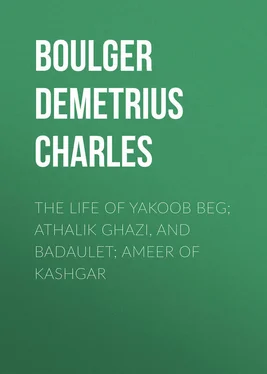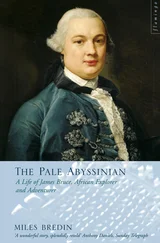Demetrius Boulger - The Life of Yakoob Beg; Athalik Ghazi, and Badaulet; Ameer of Kashgar
Здесь есть возможность читать онлайн «Demetrius Boulger - The Life of Yakoob Beg; Athalik Ghazi, and Badaulet; Ameer of Kashgar» — ознакомительный отрывок электронной книги совершенно бесплатно, а после прочтения отрывка купить полную версию. В некоторых случаях можно слушать аудио, скачать через торрент в формате fb2 и присутствует краткое содержание. ISBN: , Жанр: foreign_antique, foreign_prose, на английском языке. Описание произведения, (предисловие) а так же отзывы посетителей доступны на портале библиотеки ЛибКат.
- Название:The Life of Yakoob Beg; Athalik Ghazi, and Badaulet; Ameer of Kashgar
- Автор:
- Жанр:
- Год:неизвестен
- ISBN:http://www.gutenberg.org/ebooks/33712
- Рейтинг книги:5 / 5. Голосов: 1
-
Избранное:Добавить в избранное
- Отзывы:
-
Ваша оценка:
- 100
- 1
- 2
- 3
- 4
- 5
The Life of Yakoob Beg; Athalik Ghazi, and Badaulet; Ameer of Kashgar: краткое содержание, описание и аннотация
Предлагаем к чтению аннотацию, описание, краткое содержание или предисловие (зависит от того, что написал сам автор книги «The Life of Yakoob Beg; Athalik Ghazi, and Badaulet; Ameer of Kashgar»). Если вы не нашли необходимую информацию о книге — напишите в комментариях, мы постараемся отыскать её.
The Life of Yakoob Beg; Athalik Ghazi, and Badaulet; Ameer of Kashgar — читать онлайн ознакомительный отрывок
Ниже представлен текст книги, разбитый по страницам. Система сохранения места последней прочитанной страницы, позволяет с удобством читать онлайн бесплатно книгу «The Life of Yakoob Beg; Athalik Ghazi, and Badaulet; Ameer of Kashgar», без необходимости каждый раз заново искать на чём Вы остановились. Поставьте закладку, и сможете в любой момент перейти на страницу, на которой закончили чтение.
Интервал:
Закладка:
Kashgar is situated in a plain in the north of the province, and the small river on which it is built is known as the Kizil Su. Immediately beyond it the country becomes hilly and mountainous, until in the far distance may be seen the snow-clad peaks of the Tian Shan, and the Aksai Plateau. Although the population is barely 30,000, there is now an air of brisker activity in the bazaars and caravanserais of this capital than in any other city in the country. The trade carried on with Russia in recent years has given some life to the place; but few, if any, merchants proceed more inland than this, whether they come from Khokand or from Kuldja. The town stretches on both sides of the river, which is crossed by a wooden bridge; but there are no buildings of any pretensions for external beauty or internal comfort. The orda or palace of the Ameer, which is in Yangy Shahr, five miles from the city, is a large gloomy barrack of a place with several buildings within each other; the outer ones are occupied by the household troops and by the court officials, and the inner one of all is set apart for the family and serai of the ruler himself. In connection with this is a hall of audience, in which he receives in solemn state such foreigners as it seems politic for him to honour. In the old days, Kashgar used to be a strongly fortified position, but the only remains of its former strength are the ruins which are strewn freely all around. Kashgar is, therefore, an open and quite defenceless town, and lies completely at the mercy of any invader who might come along the high road from Aksu or Bartchuk, or across the mountains from Khokand or Kuldja; but at Yangy Shahr, about five miles south of Kashgar, Yakoob Beg constructed a strong fort, where he deposited all his treasure, and this may be taken to be the citadel of Kashgar as well as the residence of the ruler. Yangy Shahr means new city, and as a fortification erected by a Central Asian potentate with very limited means, it must be considered to be a very creditable piece of military workmanship. The Andijanis or Khokandian merchants who have at various times settled here, form a very important class in this town in particular, and it was they who more than any one else contributed to the success of the invasion of Buzurg Khan and Mahomed Yakoob. It is, however, said that these merchant classes had become to some extent dissatisfied with the late state of things, whether because Yakoob Beg did not fulfil all his promises, or for some other reason, is not clear. If Kashgar under its late rule was not restored to that prosperous condition which excited the admiration of Marco Polo, and the Chinese traveller, Hwang Tsang, before him, it may be considered to have been as fairly well-doing as any other city in either Turkestan, while life and property were a great deal more secure than in some we could mention.
Situated about half-way on the road to Yarkand is Yangy Hissar, a town which has always been of importance both as a military position and as a place of trade. It has greatly fallen into decay, however, but still possesses a certain amount of its former influence from being a military post, and from the exceptional fertility of the neighbouring country.
Yarkand, about eighty miles as the crow flies, and 120 by road, to the south-east of Kashgar, is still the most populous of all the cities of Eastern Turkestan. It lies in the open plain on the Yarkand river, and its walls, four miles in circuit, testify to its former greatness. Under the Chinese it was quite the most flourishing town in the region, and even now Sir Douglas Forsyth estimates that it contains 40,000 people, while the surrounding country has nearly 200,000 more. The fruit gardens and orchards, which extend in a wide belt round it, give an air of peculiar prosperity to the country, and quite possibly induce travellers to take a too sanguine view of the resources of the country. In addition to the abundance of fruit and grain produce that is brought into the city for sale, there is a large and profitable business carried on in leather. Yarkand has almost a monopoly of this article, and the consumption of it is very great indeed. The Ameer himself took large quantities yearly for his army, for, in addition to that required for boots and saddles, many of his regiments wore uniforms of that substance.
But, although Yarkand is the chief market-place of the richest province, and although its population is thriving and energetic, there is a general consensus of opinion that it has become much less prosperous and much more of a rural town since the transference of the seat of government to Kashgar, and the disappearance of Chinese merchants with the Chinese ruler. A very intelligent merchant of the town replied as follows to questions put to him, as to the Chinese and native rulers, and it will be seen that it was especially favourable to the claims of the Chinese as the better masters.
"What you see on market-day now, is nothing to the life and activity there was in the time of the Khitay. To-day the peasantry come in with their fowls and eggs, with their cotton and yarn, or with their sheep and cattle and horses for sale, and they go back with printed cotton, a fur cap, or city made boots, or whatever domestic necessaries they may require, and always with a good dinner inside them; and then we shut up our shops and stow away our goods till next week's market-day brings back our customers. Some of us, indeed, go out with a small venture in the interim to the rural markets around, but our great day is market-day in town. It was very different in the Khitay time. People then bought and sold every day, and market-day was a much jollier time. There was no Kazi Rais, with his six Muhtasib, armed with the dira to flog people off to prayer, and drive the women out of the streets, and nobody was bastinadoed for drinking spirits and eating forbidden meats. There were mimics and acrobats, and fortune-tellers and story-tellers, who moved about amongst the crowd and diverted the people. There were flags and banners and all sorts of pictures floating at the shop fronts; and there was the jallab , who painted her face and decked herself in silks and laces to please her customers." And then, replying to a question whether the morals were not more depraved under this system than under the strict Mahomedan rule of the Athalik Ghazi, the same witness went on to say – "Yes, perhaps so. There were many rogues and gamblers too, and people did get drunk and have their pockets picked. But so they do now, though not so publicly, because we are under Islam, and the shariàt is strictly enforced."
This very graphic piece of evidence gives a clearer picture of the two systems of government, than perhaps paragraphs of explanatory writing; and, to return to the immediate subject before us, it shows that Yarkand has deteriorated in wealth and population since the Chinese were expelled from it fifteen years ago.
Khoten is situated 150 miles south-east of Yarkand, and about ninety miles due east of Sanju. It lies on the northern base of the Kuen Lun Mountains, and is the most southern city of any importance in Kashgaria. Under the Chinese, it was one of the most flourishing centres of industry, and as the entrepôt of all trade with Tibet it held a bustling active community. The Chinese called it Houtan, and even now it is locally called Ilchi. In addition to the wool and gold imported from Tibet, it possessed gold mines of its own in the Kuen Lun range, and was widely celebrated for its musk, silk, and jade. It likewise has suffered from the departure of the Chinese; and the energy and wealth of that extraordinary people have found, in the case of this city also, a very inadequate substitute in the strict military order and security introduced by Yakoob Beg.
Ush Turfan, New Turfan, is a small town on the road from Kashgar to Aksu, and is not to be confounded with the better known Turfan which is situated in the far east on the highway to Kansuh. This latter town is called Kuhna Turfan, or Old Turfan, to distinguish it from the other. Ush Turfan, without ever having been a place of the first importance, derived very considerable advantage from its position on the road followed by the Chinese caravans, and Yakoob Beg converted it into a strong military position by constructing several forts there.
Читать дальшеИнтервал:
Закладка:
Похожие книги на «The Life of Yakoob Beg; Athalik Ghazi, and Badaulet; Ameer of Kashgar»
Представляем Вашему вниманию похожие книги на «The Life of Yakoob Beg; Athalik Ghazi, and Badaulet; Ameer of Kashgar» списком для выбора. Мы отобрали схожую по названию и смыслу литературу в надежде предоставить читателям больше вариантов отыскать новые, интересные, ещё непрочитанные произведения.
Обсуждение, отзывы о книге «The Life of Yakoob Beg; Athalik Ghazi, and Badaulet; Ameer of Kashgar» и просто собственные мнения читателей. Оставьте ваши комментарии, напишите, что Вы думаете о произведении, его смысле или главных героях. Укажите что конкретно понравилось, а что нет, и почему Вы так считаете.












